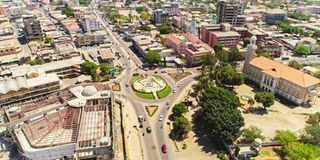Prime
Revealed: Tanzania’s rising economic powerhouses

A bird’s-eye view of a section of Dodoma. A new Bank of Tanzania report ranks Dodoma among five regions with the fastest growing economies. PHOTO | FILE
What you need to know:
- Njombe, Simiyu, Dodoma, Coast and Kagera recorded the fastest economic growth at the regional level from 2018 to 2022, according to data from the Bank of Tanzania’s 2023 Consolidated Zonal Economic Performance Report
Dar es Salaam. With Dar es Salaam having continuously retained its status as Tanzania’s biggest and most important economic hub, attention is increasingly turning to regions that have posted impressive growth in recent years.
Njombe, Simiyu, Dodoma, Coast and Kagera recorded the fastest economic growth at the regional level from 2018 to 2022, according to data from the Bank of Tanzania’s 2023 Consolidated Zonal Economic Performance Report.
Despite having lower GDP figures than Dar es Salaam and other major urban centres, these regions posted notable growth during the five-year period.
Njombe’s GDP surged 48 percent from Sh2.08 trillion to Sh3.09 trillion, while Simiyu’s jumped 44.72 percent from Sh2.12 trillion to Sh3.07 trillion.
Dodoma’s GDP grew from Sh3.71 trillion to Sh5.3 trillion, representing a 42.86 percent expansion, with Coast posting 42.53 percent growth from Sh2.4 trillion to Sh3.42 trillion.
Kagera also witnessed significant growth, with its GDP expanding by 39 percent to hit Sh4.35 trillion from Sh3.22 trillion.
In contrast, Dar es Salaam’s GDP grew by 34 percent from Sh21.63 trillion to Sh29.02 trillion during the same period. Dar es Salaam posted the slowest growth with the exception of Shinyanga, whose GDP expanded by 33.84 percent from Sh4.45 trillion to Sh5.96 trillion.
Dr Daudi Ndaki of Mzumbe University said regions such as Njombe, Simiyu, Dodoma, Coast and Kagera are prioritising investment in infrastructure, education and healthcare, which explains their impressive economic growth rates from 2018 to 2022.
He added, however, that that it was not entirely surprising that Dar es Salaam posted one of the slowest growth rates.
“It’s the norm that the larger the economy, the slower the growth. That’s why you will see that Tanzania’s economy, for instance, is growing much faster than the GDPs of many developed countries,” Dr Ndaki said.
University of Dar es Salaam Business School assistant lecturer Godsaviour Christopher said the five regions’ economies are growing fast due to increased investment and untapped potential for growth.
“These regions still have many investment opportunities, while big cities such as Dar es Salaam have already used up a great deal of available resources and are approaching full capacity,” he said.
Regions such as Njombe are leading the way in commercialised agriculture, livestock development, forestation and the development of small businesses.
According to official statistics, just over 184,000 of arable land are available for investment in Njombe for the cultivation of maize, tomatoes, Irish potatoes, beans, pineapples, avocados, tea production, flowers and timber.
The 2022 national economic survey by the Finance ministry noted that Njombe was among regions with the highest number of irrigation schemes.
As for Simiyu, agriculture and livestock keeping are the region’s economic mainstay. Another key economic activity is fishing on Lake Victoria in Busega District and Lake Kitangiri in Meatu District.
A vision has also been developed to make Dodoma Region economically competitive, socially inclusive, environmentally sustainable, vibrant, safe and convenient.
Part of Dodoma City’s master plan includes the Nala industrial hub, where the city council has designated land about 20 kilometres from the city centre to be developed to accommodate industries of all categories and logistics, storage and hospitality facilities.
Another major project is the envisaged Mpunguzi industrial hub in the south of the city, which is being developed to house facilities for manufacturing, processing and packaging of grape products due to the area’s proximity to vineyards.
Coast Region has in recent years emerged as a key destination of strategic projects such as the Julius Nyerere Hydro Power Project (JNHPP), which is being implemented in Rufiji District.
The region is also home to more than 1,500 industries located in various industrial hubs, according to regional authorities.
Kagera Region is known for its agriculture, beautiful lush landscapes and wildlife. Trade is an important occupation in the region. Other key economic activities include mining, agro-forestry, beekeeping, tourism, fisheries and small-scale industries.





